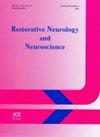髋部骨折是认知能力下降和痴呆的潜在诱因
IF 1.6
4区 医学
Q4 NEUROSCIENCES
引用次数: 0
摘要
本文综述了髋部骨折与认知能力下降和痴呆之间的可能联系。越来越多的临床研究文献表明,认知能力下降与谵妄的出现有关,而谵妄是痴呆的前兆。髋部骨折被认为是可能导致认知能力下降和痴呆的一个独立因素。当谵妄表明需要采取预防措施以保护髋部骨折患者的福利时,成本影响不应成为确定最佳康复方案的障碍。本文章由计算机程序翻译,如有差异,请以英文原文为准。
Hip Fracture As A Potential Contributor To Cognitive Decline And Dementia
This paper reviews the possible link between hip fracture and cognitive decline and dementia. There is a growing body of clinical research literature that indicates that cognitive decline is associated with the presence of delirium and that delirium is a predictor of dementia. Hip fracture is thought to be an independent factor that may lead to cognitive decline and dementia. It is suggested that cost implications should not become an obstacle to determining the best course of rehabilitation when delirium signals the need for preventive measures to protect the welfare of patients with hip fracture.
求助全文
通过发布文献求助,成功后即可免费获取论文全文。
去求助
来源期刊
CiteScore
5.40
自引率
3.60%
发文量
22
审稿时长
>12 weeks
期刊介绍:
This interdisciplinary journal publishes papers relating to the plasticity and response of the nervous system to accidental or experimental injuries and their interventions, transplantation, neurodegenerative disorders and experimental strategies to improve regeneration or functional recovery and rehabilitation. Experimental and clinical research papers adopting fresh conceptual approaches are encouraged. The overriding criteria for publication are novelty, significant experimental or clinical relevance and interest to a multidisciplinary audience. Experiments on un-anesthetized animals should conform with the standards for the use of laboratory animals as established by the Institute of Laboratory Animal Resources, US National Academy of Sciences. Experiments in which paralytic agents are used must be justified. Patient identity should be concealed. All manuscripts are sent out for blind peer review to editorial board members or outside reviewers. Restorative Neurology and Neuroscience is a member of Neuroscience Peer Review Consortium.

 求助内容:
求助内容: 应助结果提醒方式:
应助结果提醒方式:


